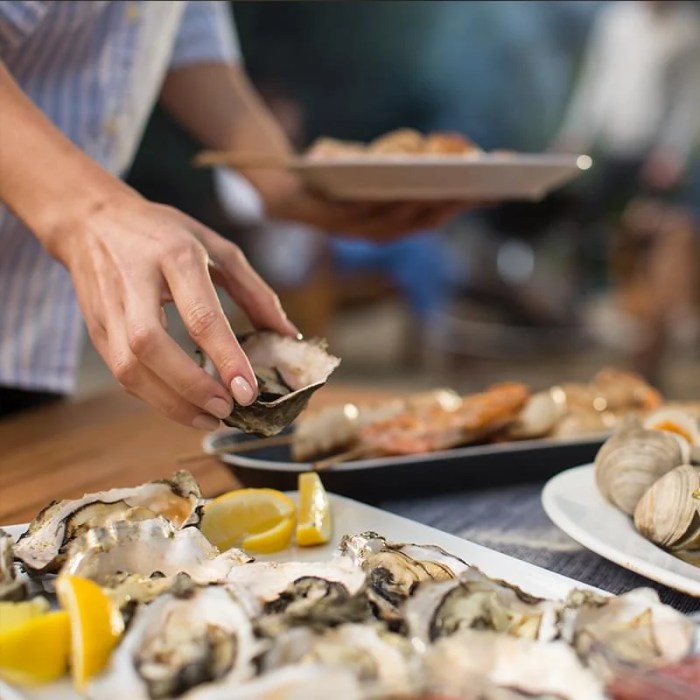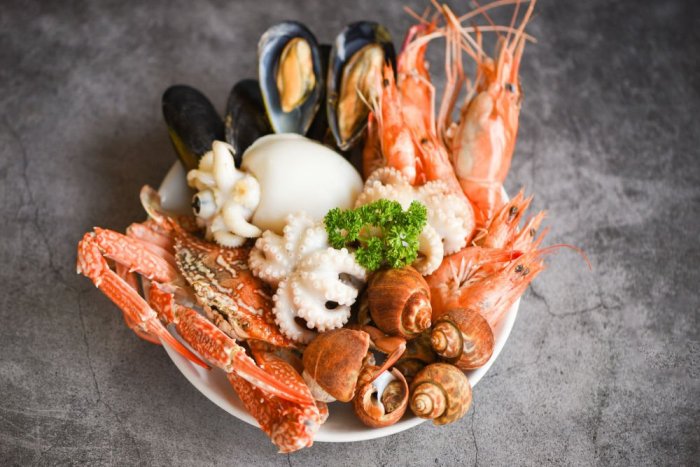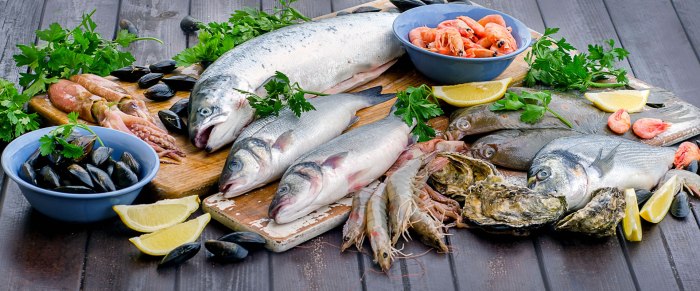Prepares all fish and shellfish items – Preparing all fish and shellfish items is a culinary skill that requires precision, knowledge, and a deep understanding of the delicate nature of these aquatic delicacies. From filleting and shucking to grilling and steaming, this comprehensive guide delves into the intricacies of preparing fish and shellfish, ensuring that every dish showcases the inherent flavors and textures of these marine treasures.
Throughout this exploration, we will uncover the techniques used to prepare fish and shellfish, emphasizing sanitation and safety, and delve into the various cooking methods that bring out the best in these culinary delights. Seasoning and flavoring will be discussed, highlighting the herbs, spices, and sauces that complement fish and shellfish, and finally, we will explore presentation and garnishing techniques that elevate these dishes into visually stunning masterpieces.
Preparation Techniques

Preparing fish and shellfish involves various techniques to enhance their taste, texture, and safety. Filleting involves removing the backbone and rib bones, creating boneless fillets. Scaling removes the scales from the skin, improving the appearance and reducing bitterness. Skinning removes the skin, leaving only the flesh, which is preferred for certain dishes.
Shucking removes the hard outer shell of shellfish, such as oysters or clams, to expose the edible meat.
Different Types of Fish and Shellfish
- Salmon:Filleting or baking
- Tuna:Steaks or grilling
- Cod:Filleting or poaching
- Shrimp:Peeling or grilling
- Clams:Steaming or shucking
Benefits and Drawbacks
- Filleting:Removes bones, creates boneless cuts
- Scaling:Improves appearance, reduces bitterness
- Skinning:Removes tough skin, preferred for certain dishes
- Shucking:Exposes edible meat, allows for easy cooking
Sanitation and Safety

Proper sanitation and safety are crucial when preparing fish and shellfish to prevent foodborne illnesses. Raw or undercooked fish and shellfish can harbor harmful bacteria, viruses, and parasites. Maintaining cleanliness, using proper equipment, and cooking to the recommended internal temperature are essential for safe consumption.
Potential Hazards
- Bacteria:Salmonella, Listeria
- Viruses:Norovirus
- Parasites:Anisakis, tapeworms
Guidelines for Safe Handling
- Wash hands before and after handling
- Clean and disinfect surfaces and equipment
- Store fish and shellfish at proper temperatures
- Cook to recommended internal temperatures
Cooking Methods
Choosing the appropriate cooking method for fish and shellfish is essential to enhance their flavor and texture. Grilling provides a charred exterior and tender interior. Baking creates a moist and flaky texture. Frying produces a crispy crust. Steaming preserves nutrients and results in a delicate texture.
Poaching gently cooks fish in a flavorful liquid.
Different Cooking Methods
- Grilling:Salmon, tuna
- Baking:Cod, halibut
- Frying:Shrimp, calamari
- Steaming:Clams, mussels
- Poaching:Trout, tilapia
Advantages and Disadvantages
- Grilling:Imparts a smoky flavor, but can dry out fish
- Baking:Retains moisture, but may lack flavor
- Frying:Creates a crispy exterior, but can be high in fat
- Steaming:Preserves nutrients, but can result in a bland flavor
- Poaching:Gentle cooking method, but may not develop as much flavor
Seasoning and Flavoring

Seasoning and flavoring enhance the natural taste of fish and shellfish. Herbs, spices, marinades, and sauces complement different types of fish and shellfish, adding depth and complexity to dishes. It is important to balance flavors to avoid overpowering the delicate taste of fish and shellfish.
Common Seasonings and Flavorings, Prepares all fish and shellfish items
- Herbs:Dill, parsley, thyme
- Spices:Garlic, paprika, lemon pepper
- Marinades:Citrus juices, olive oil, herbs
- Sauces:Lemon butter, hollandaise, tartar sauce
Importance of Balancing Flavors
Balancing flavors is essential to create harmonious dishes. Overpowering the delicate taste of fish and shellfish with strong flavors should be avoided. Use seasonings and flavorings sparingly and taste throughout the cooking process to adjust as needed.
Presentation and Garnishing

Presentation and garnishing enhance the visual appeal and overall dining experience. Creative and visually appealing presentation styles add value to the dish. Garnishes, such as herbs, citrus wedges, or edible flowers, complement the flavors and enhance the appearance.
Presentation Techniques
- Plating:Arrange fish and shellfish on a plate in an aesthetically pleasing manner
- Skewering:Thread fish or shellfish onto skewers for a unique presentation
- Folding:Fold fish fillets or shellfish into decorative shapes
Use of Garnishes
- Herbs:Parsley, dill, cilantro
- Citrus Wedges:Lemon, lime, orange
- Edible Flowers:Nasturtium, pansies
Importance of Presentation
Well-presented dishes enhance the dining experience and leave a lasting impression on guests. Garnishes and creative presentation techniques add visual interest and complement the flavors of the dish.
FAQs: Prepares All Fish And Shellfish Items
What are the essential techniques for preparing fish?
Filleting, scaling, skinning, and gutting are fundamental techniques for preparing fish.
How do I ensure the safety of shellfish?
Purchase shellfish from reputable sources, cook them thoroughly, and discard any that do not open during cooking.
What are the best cooking methods for fish?
Grilling, baking, frying, steaming, and poaching are all suitable cooking methods for fish, depending on the desired texture and flavor.